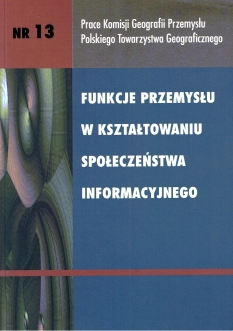Ewolucja przemysłu zaawansowanej technologii i sektora teleinformatycznego (ICT) w Finlandii
DOI:
https://doi.org/10.24917/20801653.13.10Słowa kluczowe:
ICT, przemysł wysokich technologiiAbstrakt
The paper presents in a broad outline the main characteristics of the evolution of the Finnish high-tech industry and ICT sector within the context of general changes in industry and the national economy. In the last decades of the 20th century Finland dynamically developed a knowledge-based economy and became one of the leaders of the information society. A spectacular manifestation of this is the position of the country in global competitiveness rankings, where Finland has occupied a top position for several years, sometimes even being ahead of the United States. The so-called ‘Finnish model of information society’ is characterised, among others, by a significant growth in knowledge-intensive industries and a complex system of research and development support. However, all those changes were dependent on the previous development path of the country. The structure of Finnish industry was rather one-sided until the 1980s, when knowledge- and expertise-intensive production started to catch up with the level of manufacturing dominated by raw materials, capital and energy. For a long time, Finland specialised in the forest industry and in the processing of metals. A new sector that has developed during the past decades is electronics and, especially, the manufacturing of communication devices. Furthermore, the economy has changed more dramatically in Finland than in any other developed country over the same period of time. Industries have become technology-intensive and production is strongly characterised by specialisation. Finland has become the most specialised country in information and communication technology in the world, and this specialisation trend is continuing. The forest industry and other traditional industries rely more and more on the new technologies and state-of-the-art knowledge. In Finland, industrialisation started later than in other countries, but it was very rapid. Industrial production and exports grew faster than the rest of the economy in the 1990s, and the structure of exports diversified. Unlike other developed countries, Finland “re-industrialised” in the 1990s. The contribution of industry to the total volume of production and employment has been higher in Finland than in other advanced economies in the past couple of years.Downloads
Metrics
Bibliografia
Ali-Yrkkö J., Hermans R., 2002, Nokia in the Finnish innovation system. ETLA Discussion Papers, 811, ETLA – The Research Institute of the Finnish Economy, Helsinki.
Castells M., Himanen P., 2002, The information society and the welfare state: The Finnish model. Oxford University Press, New York.
Dahlman C.J., Routti J., Ylä-Anttila P., 2006, Finland as a knowledge economy: Elements of success and lessons learned, World Bank, Washington.
Gergils H., 2006, Dynamic innovation systems in the Nordic countries? Denmark, Finland, Iceland, Norway and Sweden, SNS, Stockholm.
Kiander J., Kröger O., Romppanen A. red., 2006, Finnish economy: Structural indicators, Government Institute for Economic Research, Helsinki.
Maliranta M., 2004, Creative destruction in Finnish manufacturing, Finnish Economy and Society, 1, s. 97–101.
Mannio P., Vaara E., Ylä-Anttila P. red., 2003, Our path abroad: Exploring post-war internationalization of Finnish corporations, Taloustieto, Helsinki.
OECD, 2005, OECD Science, technology and industry scoreboard, OECD, Paris.
Oinas P., 2005, Finland: A success story? European Planning Studies, 13, 8, s. 1227–1244.
Ojala J., Eloranta J., Jalava J. red., 2006, The road to prosperity: An economic history of Finland, Suomalaisen Kirjallisuuden Seura, Helsinki.
Porter M.E., 1990, The competitive advantage of nations, Macmillan, London.
Porter M.E., 1998, The competitive advantage of nations – the Finnish case, [w:] D. Steinbock red., The competitive advantage of Finland: From cartels to competition?, Taloustieto, Helsinki.
Porter M.E., 2004, Global competition, clusters and Finland´s Wireless Valley, [w:] D. Steinbock red., What Next? Finnish ICT cluster and globalization, Ministry of Interior, Helsinki, s. 13–17.
Rouvinen P., Ylä-Anttila P., 2004, Little Finland’s transformation to a wireless giant, [w:] S. Dutta, B. Lanvin, F. Paua red., The global information technology report 2003–2004: Towards an equitable information society, Oxford University Press, New York, s. 87–108.
Schienstock G., Hämäläinen T., 2001, Transformation of the Finnish innovation system: A network approach, Sitra Reports, 7, Sitra, Helsinki.
Stachowiak K., 2008, Czynniki instytucjonalne w budowaniu i funkcjonowaniu gospodarki opartej na wiedzy – przykład Finlandii, [w:] J.J. Parysek, T. Stryjakiewicz red., Region społeczno-ekonomiczny i rozwój regionalny. Bogucki Wydawnictwo Naukowe, Poznań, s. 121–151.
Steinbock D., 2004, What next? Finnish ICT cluster and globalization, Ministry of Interior, Helsinki.
TIEKE, 2006, ICT Cluster Finland Review 2006. TIEKE – Finnish Information Society Development Centre, Helsinki.
Vaattovaara M., Kortteinen M., 2003, Beyond polarisation versus professionalisation? A case study of the development of the Helsinki region, Finland, Urban Studies, 40, 11, s. 2127–2145.
Wierzbołowski J., 2003, Fińska droga do społeczeństwa informacyjnego i gospodarki opartej na wiedzy, Instytut Łączności, Warszawa.
Pobrania
Opublikowane
Jak cytować
Numer
Dział
Licencja
Artykuły publikowane są zgodnie z warunkami licencji Creative Commons (CC BY-ND 4.0; uznanie autorstwa-bez utworów zależnych).

